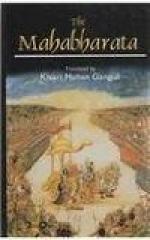307. Vajrasuchyagram may also mean furnished with an end like that of the needle with which diamonds and other hard gems are bored through.
308. The ever-changing beautiful masses of afternoon or evening clouds, presenting diverse kinds of forms almost every minute, are regarded as the abodes or mansions of the Gandharvas.
309. Some of these trees and creepers are identifiable. Sahakara is Mangifera Indica, Linn. Ketaka is a variety of Pandanus Odoratissimus, Linn. Uddalaka is otherwise called Vahuvara and sometimes Selu. It is the Cordia Myxa, Linn. It may be a misreading for Uddanaka, which is the well-known Cirisha or the Mimosa Sirisca of Roxburgh. Dhava is Conocarpus latifolia, Roxb. Asoka is Saraca Indica, Linn., syn, Jonesia Asoka, Roxb. Kunda is Jasminum pubescens, Linn. Atimukta is otherwise called Madhavi. It is Gaertinera racemosa, Roxb. Champaka is Michelia Champaca, Linn. Tilaka sometimes stands for Lodhra, i.e., Symplocos racemosa, Roxb. The word is sometimes used for the Aswattha or Ficus religiosa, Linn. Bhavya is Dillenia Indica, Linn. Panasa is Artocarpus integrifolia, Linn. The Indian Jack-tree. Vyanjula stands for the Asoka, also Vetasa (Indian cane), and also for Vakula, i.e., Mimusops Elengi, Linn. Karnikara is Pterospermum accrifolium, Linn. Cyam#a is sometimes used for the Pilu, i.e., Salvadora Persica, Linn. Varanapushpa or Nagapushpa or Punnaga is Colophyllum inophyllum, Linn. Astapadika or padika is otherwise called Bhardravalli. It is the Vallaris dichotoma, Wall., Syn., Echites dichotoma, Roxb.
310. Bhringaraja is the Lanius Malabaricus. Kokila is the well-known Indian Koel or cuckoo. Catapatra is the wood-pecker. Koyashtika is the Lapwing. Kukkubhas are wild-cocks (Phasinus gallus). Datyuhas are a variety of Chatakas or Gallinules. Their cry resembles the words (phatikjal). Jivajivaka is a species of partridges. Chakora is the Greek partridge. Sarasa is the Indian crane. Chakravaka is the Brahmini duck or goose.
311. In verse 39 and 40 for asmi and tapacchaitat read asi and tapasaccha.
312. The Grandsire spoke of somebody becoming a Kshatriya in Bhrigu’s race, and referred to the incident as the result of a stain that would be communicated to that race from Kusika’s. This is the full allusion.
313. The sense seems to be that Kusika wishes to know what person of Bhrigu’s race will confer this high benefit upon his race.
314. By ancestors to the seventh degree also descendants to the same degree are meant.
315. Heaven and Hell are places of only enjoyment and endurance. There can be no acts there leading to merit or demerit. This world is the only place which is called the field of acts.
316. Vrikshas are large or small trees generally. Gulma is a shrub, or bushy plant. Lata is a creeper, which cannot grow without a support. Talli is of the same variety, with this difference, perhaps, that its stems are more tree-like than those of creepers. Twaksara is the bamboo. Trina includes all kinds of grass.




